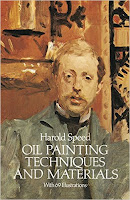
Welcome to the GJ Book Club. Today we'll cover pages 187-192 of the chapter on "Tone and Colour Design," from Harold Speed's 1924 art instruction book
Oil Painting Techniques and Materials
.
I'll present Speed's main points in boldface type either verbatim or paraphrased, followed by my comments. If you want to add a comment, please use the numbered points to refer to the relevant section of the chapter.
1. Gradated and Flat Tones
Speed covered this topic in his book on drawing as well. He suggests planning the picture in flat tones and to "let your gradations be the result of such tones melting into each other where necessary." Form that is conceived in planar terms has more vigor, he argues, compared to smoothly curving form, which can start looking effete or feeble.
 |
| Turner - Norham Castle Sunrise |
2. Lost Edges
Speed says that a good place to put gradations is in the edges between the big flat shapes. "The larger the number of these lost edges the more gracious the expression, and the larger the number of hard edges, the more forceful and less gracious the expression." As with all painterly aesthetics, an intelligent mix of both is the best bet.
3. Range of Tone
Here's another principle: "The smaller the range of tone used, the quieter and more peaceful the result." In the Turner sunrise painting, the values are kept close and the edges are kept soft, creating a gentle effect, like a shimmering tremolo on the violin. Note that he didn't use pure white for the sun, but shifted hue and chroma from a light gray sky to a high-chroma yellow sun. The piece is high in key and is saved by the solitary dark accent of the cow (or is it a horse? I can't tell).
Whether Turner pushes his effects too far in his late work is a matter of taste; I prefer his earlier work where the effects are more understated. I think Frederic Church is better at Turner than Turner is.
The reverse is also effective: a mostly dark painting with a single light accent, as with the Bierstadt nocturne below:
 |
| Bierstadt Ships at Night |
Speed says: "When the full scale is used and the tones strongly contrasted you get the most dramatic effects. But when the full scale is used but the tones are not strongly contrasted but gradate quietly into the other, you get an effect that is neither dramatic nor peaceful but simply a strong normal effect."
 |
| Giorgione's Holy Family with Saints |
4. Giorgione's Holy Family with Saints
Note the central position of the Madonna, but the varied handling of the flanking figures.
5. Giorgione's Fête Champêtre (Pastoral Concert)
Speed admires the wide range of tone without dramatic edge contrasts. Contrast between gentle form modeling on figures to staccato accents on the drapery.
6. Poussin's Flight into Egypt
Speed seems to greatly admire this painting. He analyzes the piece by sketching a tone plan and a diagram of line rhythms, and he breaks down the composition in tonal terms. Personally, I don't see this as being a very exemplary work. It has so many confused centers of interest and awkward, stiff passages. What is the baby Jesus most worried about: the concrete clouds, the heavy handed foreshadowing, or his distracted parents? Sorry, I've just never been a big fan of Poussin.

Next week—We'll continue with the Veronese on page 192.
-----
----
GurneyJourney YouTube channel
My Public Facebook page
GurneyJourney on Pinterest
JamesGurneyArt on Instagram
@GurneyJourney on Twitter
































.jpg)